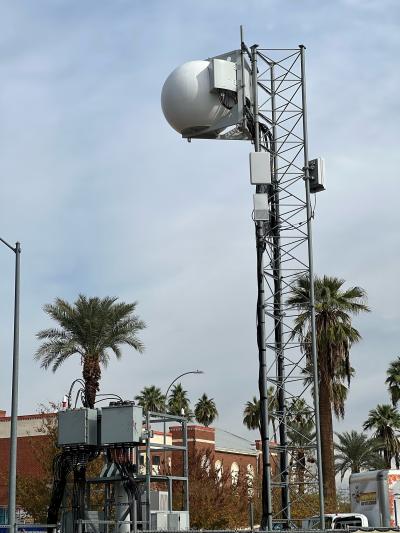T-Mobile kicked off the week touting big strides in its network in the Phoenix area, which hosts the Super Bowl on February 12. T-Mobile said it amped speeds by 10x inside State Farm Stadium and by 4x across the region.
Like its rivals making network upgrades for the Super Bowl, these changes will be permanent, so customers will see the benefits for years to come.
Inside the stadium, T-Mobile boosted 2.5 GHz coverage and capacity with indoor distributed antenna system (DAS) upgrades and launched 600 MHz of millimeter wave (mmWave) spectrum for download speeds up to 10x faster than before.
Beyond the stadium, T-Mobile added towers, enhanced backhaul and bumped up the amount of 2.5 GHz spectrum that customers can tap into. Small cells were added to densify the network in areas where crowds are expected.
T-Mobile also made a point to say it’s the fastest mobile network in 45 states, including Arizona, based on Ookla tests.
Fierce checked with rivals Verizon and AT&T to see what they’re doing to prepare for the big event.
Verizon talks Frontline
If all goes well on February 12 at State Farm Stadium, it will be like seeing a swan float gracefully over the water. No one will ever see the feet quickly paddling under the water to make it all happen.
That’s how Maggie Hallbach, SVP of the Public Sector business at Verizon, describes the intended outcome after years of effort on the part of Verizon technicians working to prepare the venue and surrounding area for Super Bowl 57.
They’ve been working for decades, and in particular since the NFL identified State Farm Stadium as the 2023 Super Bowl venue, spending to the tune of over $100 million to harden the infrastructure.
Although AT&T won the FirstNet contract for supplying the nation’s first dedicated public safety LTE network, Verizon still serves more first responders than any other provider – by nearly a 2:1 margin, she said. Hallbach oversees Frontline, which serves public safety agencies.
Asked if the city of Phoenix Police Department is one of Verizon’s customers, she said Verizon avoids getting too specific about customers and noted the FCC’s Customer Proprietary Network Information (CPNI) rules. However, “we have a very broad representation of customers across the Phoenix metro area,” she said.
Last month, Hallbach presented at the U.S. Conference of Mayors with Phoenix Mayor Kate Gallego where they discussed how preparing for an event like this means planning for all potential eventualities and being grateful when they don’t need to use it.
That said, Verizon will have some hefty gear on hand if it needs to use it, like THOR, the Tactical Humanitarian Operations Response vehicle, as well as THOR’s Hammer and the Mobile Utility Technology Transport (MUTT) police cruiser.
In 2022, Verizon deployed C-band spectrum in and around the Phoenix area, which provides a coverage and capacity boost to the mmWave spectrum that it’s already deployed in more dense, urban settings. It also deployed some enhanced in-building systems, including in area hotels and the Phoenix Convention Center.
“What we’re trying to do is a variety of different spectrum deployments based on the use cases for what will be done in those networks,” she said. That includes adding more 4G LTE capacity using 700 and 850 MHz spectrum in more suburban settings and closer to more rural areas because that propagates the farthest.
AT&T's flying COW and robotic dog
Like Verizon, AT&T is bringing all the tools at its disposal to serve fans and public safety customers during the big game. That includes a flying cell on wheels (COW) and a robotic dog.

“We are bringing our full arsenal of tools and spectrum available to us,” including LTE, C-band and 39 GHz mmWave spectrum, said Adam Schieber, VP, Network for the Western U.S. at AT&T. “We feel really good that we’re going to deliver a great experience.”
About half of AT&T’s customers are using 5G devices and a higher percentage than that probably will be using 5G at the Super Bowl since they’re more likely to have a 5G device.
AT&T has about 200 mmWave nodes in and around the stadium, fortified with its C-band spectrum and FirstNet’s LTE Band 14. AT&T won 3.45 GHz licenses in last year’s auction, but that isn’t cleared yet.
It’s also using six of the “eyeball” MatSing antennas mounted around catwalks and pointed toward the sidelines and close to the field. There’s a total of about the 2,000 antennas inside the stadium. About 1,400 antennas are under seats, and it’s got another 500 or so omni- or panel antennas pointed downward toward the seats.
AT&T is also part of the DAS managed by Crown Castle and shared with other carriers. Despite the hyper competitive nature of the business, “there’s a level of coordination” and negotiation between operators, he said, but Crown acts as the quarterback getting them all in alignment.
Equipment like cells on light trucks (COLTs) will be there in case they’re needed. “We hope we go through this and we don’t have to deploy those and we can just leave those parked on the side of the road, but if there is an event, some kind of public safety issue, we’re bringing all the resources we have with our FirstNet spectrum and FirstNet team to support anybody who needs us,” and they’re coordinating with local public safety officials, he said.
Schieber said he will never say there’s nothing to worry about because they’re always concerned about the unknown and what might pop up. But they had a dry run at the same stadium with the Fiesta Bowl, and that event went well.
“I feel really good where we’re at right now,” he said. “We’re bringing the full arsenal of what we’ve got.”